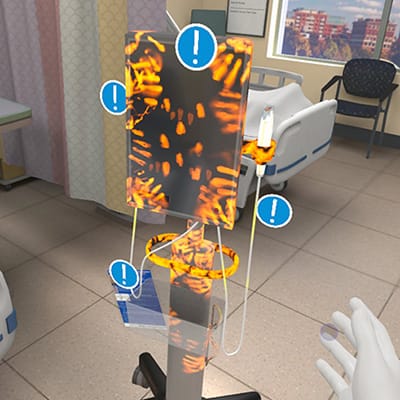Mass General Brigham’s pilot program finds clinicians respond positively to immersive infection control training.
Infection control researchers at Mass General Brigham have developed a virtual reality (VR) tool to train clinicians on core concepts in infection control, including cleaning and disinfecting portable medical equipment, to prevent the spread of infections throughout healthcare facilities.
They piloted the VR training tool at seven facilities across the United States, and their hope is that such training can increase staff competency and improve patient safety. The work is published in Infection Control & Hospital Epidemiology.
“Devices such as blood pressure cuffs, glucometers, and portable imaging machines are everywhere in healthcare, and study after study has shown healthcare is failing at cleaning and disinfecting them, leading to risk of healthcare-associated infections,” says senior author Erica S. Shenoy, MD, PhD, chief of infection control for Mass General Brigham, in a release. “We know that when core infection control practices are correctly and consistently applied, the risk to patients is reduced; but we also know that the way we have been teaching these practices for decades is not delivering.”
Healthcare-associated Infections affect 1 in 31 patients, result in almost 100,000 deaths annually, and incur $28.4 billion in direct medical costs. Up to 75% of these infections are preventable through the implementation of core infection prevention practices. Studies have reported between 25% and 100% of portable medical equipment to be contaminated, and shared portable medical equipment has been implicated in the transmission of healthcare-associated infections.
‘See the Unseen’ Risk
Shenoy and her colleagues developed an immersive VR module that uses head-mounted displays and guides learners through a simulated inpatient healthcare environment. The module incorporates gamification and visualization of invisible contamination, where learners review and apply cleaning and disinfection concepts to two different devices: a vital signs machine and a point-of-care ultrasound machine.
“We wanted clinicians to be able to ‘see the unseen’ risk and be completely immersed in a way that could lead to improved knowledge and skills when back in the real world,” says Shenoy in a release.

In the study’s initial phase, 31 participants were trained and provided feedback, which was used to revise the training module. Then, an additional 44 participants tried the revised module, 39 of whom (88.6%) reported an overall positive experience. Survey comments from learners often touted their enjoyment of the immersive and virtual, hands-on environment of the platform.
While half reported negative physical sensations (motion sickness is common among new VR users), only a few participants reported module challenges, such as difficulty with transporting portable medical equipment, donning and doffing their virtual gloves, or understanding instructions.
Testing Knowledge and Competency
Additional research is underway and has moved beyond user experience and acceptability to focus on testing learners’ knowledge, skills, and competency after training with the VR module.
“In busy, complex healthcare settings, a new kind of training is needed that increases muscle memory for these core infection control practices,” says Shenoy in a release. “Maybe not surprising, but certainly encouraging to our team, was that learners expressed joy and excitement for the training. We know that when learners are engaged, they are more likely to retain the information.”
Photo caption: A Mass General Brigham researcher wears the VR headset while she engages in an infection control training module (right); the split-screen image depicts what she is viewing in the module on the proper use of personal protective equipment (left).
Photo credit: Mass General Brigham
Related Read:





